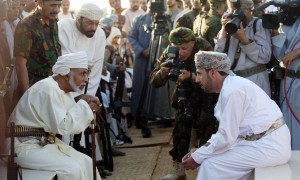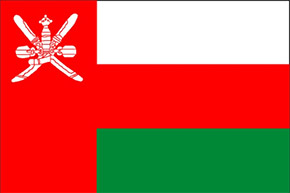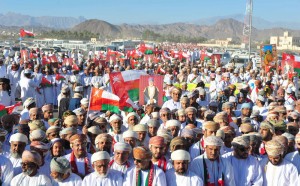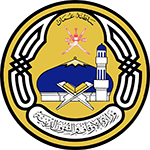Introduction
 The Sultanate of Oman enjoys a stable political, economic and social system. Mainly fuelled by high international oil prices, the economy witnessed strong growth since few years. The strength is evident in the robust expansion in GDP (+24% in 2005), rising per capita income, widening surpluses balance of payment account and rising public and private sector investment.
The Sultanate of Oman enjoys a stable political, economic and social system. Mainly fuelled by high international oil prices, the economy witnessed strong growth since few years. The strength is evident in the robust expansion in GDP (+24% in 2005), rising per capita income, widening surpluses balance of payment account and rising public and private sector investment.
Although Oman has achieved remarkable progress, the country is facing new challenges due mainly to the finite nature of oil reserves, guaranteed for 50 more years. For these reason, in June 1995, the Conference “Vision: Oman 2020” held in Muscat sets two main targets for the next twenty-five years.
The first dealt with economic diversification. In the year 2020, the crude oil sector’s share of GDP is expected to drop to around 9%, against 41% in 1996. The second target consisted in employment for the new generations by replacing expatriates with Omani staff. The aim is to achieve an “omanisation” rate of 95% in the public sector and 75% in the private sector by 2020.
To achieve it, the government in Oman focused to develop the non-oil sector and hence a policy shifting towards economic diversification. State assets have been privatized (telecommunications & power) and massive investments have been done in industry (gas, petrochemicals, aluminium) and in infrastructures for tourism sectors.
National Flag
 The National Flag carries the Sultanate’s emblem of two crossed swords with a khanjar and belt superimposed. The white portion pertains to the belief of the Omani people in peace and prosperity; the red has been adapted from the original Omani flag and the green signifies the faith in Islam and the fertility of the land.
The National Flag carries the Sultanate’s emblem of two crossed swords with a khanjar and belt superimposed. The white portion pertains to the belief of the Omani people in peace and prosperity; the red has been adapted from the original Omani flag and the green signifies the faith in Islam and the fertility of the land.
History
 Wattayah, located in the governorate of Muscat, is the oldest human settlement and dates to the Stone Age, around 10,000 years old. Findings have consisted of stone implements, animal bones, shells and fire hearths. Other discoveries include hand-moulded pottery bearing distinguishing pre-Bronze Age marks, heavy flint implements made from slivers of quartz, and sharp, pointed tools and scrapers.
Wattayah, located in the governorate of Muscat, is the oldest human settlement and dates to the Stone Age, around 10,000 years old. Findings have consisted of stone implements, animal bones, shells and fire hearths. Other discoveries include hand-moulded pottery bearing distinguishing pre-Bronze Age marks, heavy flint implements made from slivers of quartz, and sharp, pointed tools and scrapers.
Ras al-Hamra, in the north west of Muscat, contains evidence to show that the region had human settlements in the fourth millennium BC. The site consists of settlements heaped one on top of the other. The layer representing the dwellings is composed of sand, shells, fishbone, ash and coal.
A burial ground which contained 220 skeletons lying on one side in a foetal position facing the sea (the source of their subsistence) was unearthed at this site. In one case a pearl was discovered, it is one of the oldest examples found in the Gulf.
There are many locations throughout the Sultanate which represent the third millennium BC, including Bat, Ras Al-Hadd and Samad Al-Shan. Bat is east of Ibri in the Dhahirah region. A site which consisted of 100 burials made from stone was discovered. These have become known as the Bat Tombs.
The most important site dating back to the first millennium BC is located in Sohar. A settlement was unearthed there in which were found constructions below the buildings of the first century AD, indicating a flourishing settlement. The artefacts discovered show that Sohar was a significant trading centre at this time. Merchant seals were found and a type of fine terracotta earthenware, possibly imported from India. Other forms of pottery included Chinese porcelain of a type found in abundance in the first century of the Islamic Age, confirming that trade with China was flourishing then.
Frankincense brought the city of Dhofar, in the south of the Sultanate, to worldwide prominence. Field studies indicate that frankincense was transported by land and sea across the world. The crop was collected for outward transport from Ras Fartak port (Jebel Al Qamr) to Yemen and the rest of Asia, via Aden port. The land route started to the west of Dhofar and passed through the Nejd to the south of the Arabian Peninsula, then swinging north to Najran and on to Gaza. The most significant route was that which linked Dhofar with the east of the Arabian Peninsula and continued to Sumer, in Iraq. From approximately 5000 BC to around 1800 BC, Iraq’s need for incense, as supplied by Dhofar, grew.
Historians cannot give specific dates as to when Islam emerged in Oman, but documents indicate that the Prophet Mohammed contacted Oman’s leaders in 6th Hegira (AH – from the Islamic calendar). From the time of the Prophet’s death, the Arab Islamic conquest continued for around 100 years. With Oman’s strong merchant trading links, it was instrumental in spreading the region to other countries such as Persia.
In the 16th century, Oman was invaded by Portuguese troops, who were vying for control of the Gulf and the Indian Ocean. Their occupation lasted around 150 years until they were finally expelled by Sultan bin Saif al-Yarubi in 1650, this date is consider to be the start of Oman’s independence.
After the Portuguese were expelled in 1650 and while resisting Persian attempts to establish hegemony, the Sultan of Oman extended his conquests to Zanzibar, other parts of the eastern coast of Africa, and portions of the southern Arabian Peninsula. During this period, political leadership shifted from the Ibadhi imams, who were elected religious leaders, to hereditary sultans who established their capital in Muscat. By the early 19th century, Oman was the most powerful state in Arabia and had a major presence on the East African coast.
In 1861, the Omani empire –through the mediation of the British Government- was divided into two separate principalities–Zanzibar, with its East African dependencies, and Muscat and Oman. Zanzibar paid an annual subsidy to Muscat and Oman until its independence in early 1964.
In 1908, Oman entered into an agreement of friendship wirh Great Britain. This traditional association was confirmed in 1951 through a new treaty of friendship, commerce, and navigation by which the United Kingdom recognized the Sultanate of Oman as a fully independent state.
During the First World War, Oman’s economy and trade links declined and the country was left in relative isolation until 1970, when Sultan Qaboos bin Said took to the throne.
The new Sultan was confronted with insurgency in Dofar and a country plagued by endemic disease, illiteracy, and poverty. One of his first measures was to abolish many harsh restrictions, which had caused thousands of Omanis to leave the country. He offers amnesty to opponents of the previous regime, many of whom returned to Oman. He finally established a modern government structure and launched a major development program to upgrade educational and health facilities, build a modern infrastructure, and develop the country’s natural resources. The Sultanate of Oman enjoys a stable political, economic and social system. Mainly fuelled by high international oil prices, the economy witnessed strong growth since few years. The strength is evident in the robust expansion in GDP (+24% in 2005), rising per capita income, widening surpluses balance of payment account and rising public and private sector investment.
The Sultanate of Oman enjoys a stable political, economic and social system. Mainly fuelled by high international oil prices, the economy witnessed strong growth since few years. The strength is evident in the robust expansion in GDP (+24% in 2005), rising per capita income, widening surpluses balance of payment account and rising public and private sector investment.
Although Oman has achieved remarkable progress, the country is facing new challenges due mainly to the finite nature of oil reserves, guaranteed for 50 more years. For these reason, in June 1995, the Conference “Vision: Oman 2020” held in Muscat sets two main targets for the next twenty-five years.
The first dealt with economic diversification. In the year 2020, the crude oil sector’s share of GDP is expected to drop to around 9%, against 41% in 1996. The second target consisted in employment for the new generations by replacing expatriates with Omani staff. The aim is to achieve an “omanisation” rate of 95% in the public sector and 75% in the private sector by 2020.
To achieve it, the government in Oman focused to develop the non-oil sector and hence a policy shifting towards economic diversification. State assets have been privatized (telecommunications & power) and massive investments have been done in industry (gas, petrochemicals, aluminium) and in infrastructures for tourism sectors.
National Flag
 The National Flag carries the Sultanate’s emblem of two crossed swords with a khanjar and belt superimposed. The white portion pertains to the belief of the Omani people in peace and prosperity; the red has been adapted from the original Omani flag and the green signifies the faith in Islam and the fertility of the land.
The National Flag carries the Sultanate’s emblem of two crossed swords with a khanjar and belt superimposed. The white portion pertains to the belief of the Omani people in peace and prosperity; the red has been adapted from the original Omani flag and the green signifies the faith in Islam and the fertility of the land.
History
 Wattayah, located in the governorate of Muscat, is the oldest human settlement and dates to the Stone Age, around 10,000 years old. Findings have consisted of stone implements, animal bones, shells and fire hearths. Other discoveries include hand-moulded pottery bearing distinguishing pre-Bronze Age marks, heavy flint implements made from slivers of quartz, and sharp, pointed tools and scrapers.
Wattayah, located in the governorate of Muscat, is the oldest human settlement and dates to the Stone Age, around 10,000 years old. Findings have consisted of stone implements, animal bones, shells and fire hearths. Other discoveries include hand-moulded pottery bearing distinguishing pre-Bronze Age marks, heavy flint implements made from slivers of quartz, and sharp, pointed tools and scrapers.
Ras al-Hamra, in the north west of Muscat, contains evidence to show that the region had human settlements in the fourth millennium BC. The site consists of settlements heaped one on top of the other. The layer representing the dwellings is composed of sand, shells, fishbone, ash and coal.
A burial ground which contained 220 skeletons lying on one side in a foetal position facing the sea (the source of their subsistence) was unearthed at this site. In one case a pearl was discovered, it is one of the oldest examples found in the Gulf.
There are many locations throughout the Sultanate which represent the third millennium BC, including Bat, Ras Al-Hadd and Samad Al-Shan. Bat is east of Ibri in the Dhahirah region. A site which consisted of 100 burials made from stone was discovered. These have become known as the Bat Tombs.
The most important site dating back to the first millennium BC is located in Sohar. A settlement was unearthed there in which were found constructions below the buildings of the first century AD, indicating a flourishing settlement. The artefacts discovered show that Sohar was a significant trading centre at this time. Merchant seals were found and a type of fine terracotta earthenware, possibly imported from India. Other forms of pottery included Chinese porcelain of a type found in abundance in the first century of the Islamic Age, confirming that trade with China was flourishing then.
Frankincense brought the city of Dhofar, in the south of the Sultanate, to worldwide prominence. Field studies indicate that frankincense was transported by land and sea across the world. The crop was collected for outward transport from Ras Fartak port (Jebel Al Qamr) to Yemen and the rest of Asia, via Aden port. The land route started to the west of Dhofar and passed through the Nejd to the south of the Arabian Peninsula, then swinging north to Najran and on to Gaza. The most significant route was that which linked Dhofar with the east of the Arabian Peninsula and continued to Sumer, in Iraq. From approximately 5000 BC to around 1800 BC, Iraq’s need for incense, as supplied by Dhofar, grew.
Historians cannot give specific dates as to when Islam emerged in Oman, but documents indicate that the Prophet Mohammed contacted Oman’s leaders in 6th Hegira (AH – from the Islamic calendar). From the time of the Prophet’s death, the Arab Islamic conquest continued for around 100 years. With Oman’s strong merchant trading links, it was instrumental in spreading the region to other countries such as Persia.
In the 16th century, Oman was invaded by Portuguese troops, who were vying for control of the Gulf and the Indian Ocean. Their occupation lasted around 150 years until they were finally expelled by Sultan bin Saif al-Yarubi in 1650, this date is consider to be the start of Oman’s independence.
After the Portuguese were expelled in 1650 and while resisting Persian attempts to establish hegemony, the Sultan of Oman extended his conquests to Zanzibar, other parts of the eastern coast of Africa, and portions of the southern Arabian Peninsula. During this period, political leadership shifted from the Ibadhi imams, who were elected religious leaders, to hereditary sultans who established their capital in Muscat. By the early 19th century, Oman was the most powerful state in Arabia and had a major presence on the East African coast.
In 1861, the Omani empire –through the mediation of the British Government- was divided into two separate principalities–Zanzibar, with its East African dependencies, and Muscat and Oman. Zanzibar paid an annual subsidy to Muscat and Oman until its independence in early 1964.
In 1908, Oman entered into an agreement of friendship wirh Great Britain. This traditional association was confirmed in 1951 through a new treaty of friendship, commerce, and navigation by which the United Kingdom recognized the Sultanate of Oman as a fully independent state.
During the First World War, Oman’s economy and trade links declined and the country was left in relative isolation until 1970, when Sultan Qaboos bin Said took to the throne.
The new Sultan was confronted with insurgency in Dofar and a country plagued by endemic disease, illiteracy, and poverty. One of his first measures was to abolish many harsh restrictions, which had caused thousands of Omanis to leave the country. He offers amnesty to opponents of the previous regime, many of whom returned to Oman. He finally established a modern government structure and launched a major development program to upgrade educational and health facilities, build a modern infrastructure, and develop the country’s natural resources.

